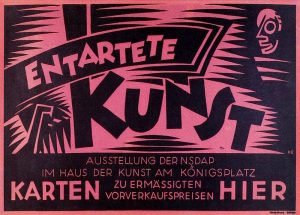The Holocaust left behind an emotionally powerful, aesthetically diverse, and ethically challenging visual landscape. This two-week summer seminar at Bowdoin College in Brunswick, Maine seeks to enrich middle school and high school curricula by investigating how history and visual culture inform each other when we seek to understand the Holocaust. By “visual culture” we mean art objects, including photomontage, sculpture, painting, book art, and film, as well as more mundane visual forms, such as posters, flags and uniforms, and magazine illustrations.
 Three primary goals inform our approach to the seminar: first, we will discuss how methods of studying visual and written texts together can be mutually reinforcing from a pedagogical perspective; second, we aim to enhance the teaching of the Holocaust by demonstrating how objects of visual culture can be studied to reveal the nature of ideological thinking, analyzed as mode of political resistance, or understood as tools of survival for victims of repression; and third, by studying works of art created in response to historical events and as a function of memory of those events, we will offer teachers ways to add an art historical dimension to their middle or high school curricula.
Three primary goals inform our approach to the seminar: first, we will discuss how methods of studying visual and written texts together can be mutually reinforcing from a pedagogical perspective; second, we aim to enhance the teaching of the Holocaust by demonstrating how objects of visual culture can be studied to reveal the nature of ideological thinking, analyzed as mode of political resistance, or understood as tools of survival for victims of repression; and third, by studying works of art created in response to historical events and as a function of memory of those events, we will offer teachers ways to add an art historical dimension to their middle or high school curricula.
 To these ends, art historian Natasha Goldman, PhD, and historian Page Herrlinger, PhD, will bring decades of experience in teaching and viewing the Holocaust through a visual lens, from the perspective of their own disciplines. At the same time, participants in the seminar will be encouraged to share their own experiences teaching with visual sources, both what they have done successfully as well as ways they have confronted the challenges unique to the visual legacy of the Holocaust and genocide. Given the increasing visual nature of the media-driven environment that younger generations of students inhabit today, the ability to analyze images and visual texts of all kinds critically seems especially timely.
To these ends, art historian Natasha Goldman, PhD, and historian Page Herrlinger, PhD, will bring decades of experience in teaching and viewing the Holocaust through a visual lens, from the perspective of their own disciplines. At the same time, participants in the seminar will be encouraged to share their own experiences teaching with visual sources, both what they have done successfully as well as ways they have confronted the challenges unique to the visual legacy of the Holocaust and genocide. Given the increasing visual nature of the media-driven environment that younger generations of students inhabit today, the ability to analyze images and visual texts of all kinds critically seems especially timely.
Out of the vast literature about the Holocaust, we have chosen readings that best help us to explore the following questions: How do works of art speak to and engage with history? What questions or ideas are elided in the visual arts and in history, and why? What is not allowed to be shown? How can visual analysis enrich historical understanding? How can one analyze works by avant-garde artists and filmmakers who were sympathetic to the National Socialists?
The materials covered and presented in our seminar will provide a rich opportunity to explore multiple perspectives on the social, artistic, and political history of the National Socialist period by examining both the production and reception of visual material and works of art. Visual material has a way of addressing both what can and cannot be spoken. And while historical material can sometimes seem dry and inaccessible for middle and high school students, the visual arts provide an opportunity for students to have an immediate feeling of mastery over the material: what they see matters. Close visual analysis leads to questions about history and representation, and these questions can be answered through further historical and art historical reading and discussion.

Reichstag. Cupola, Sir Normal Foster, 2005.
We aim to equip teachers with knowledge and information about visual culture and the Holocaust so as to make their literature, history, or other classes more enriching for their students. We welcome participants who would like to enrich their teaching and deepen their understanding of the Holocaust. Applicants may be individuals who know very little about the Holocaust, who have been teaching it for years, or who are somewhere in between. We must accept applicants from all over the nation. Foreign citizens who are US residents are eligible to apply. Individuals such as curriculum coordinators, librarians, etc., may also apply, provided they can prove that they have direct impact on student learning about the topic. As per NEH requirements, a few spots will be reserved for newcomers to the profession of teaching. Our goal is to teach, via a conversational mode, about the readings and works of art, and to give participants the opportunity to learn from each other by helping their peers develop lesson plans that integrate the new material.
